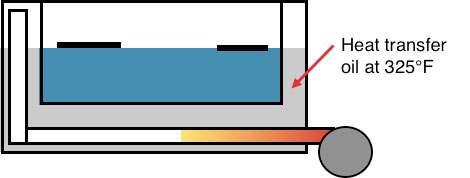Maybe you are a business owner, plant manager, or facility engineer and it is your responsibility to deal with the wastewater or spent machine coolant that is generated by your manufacturing process. Maybe you are considering purchasing a wastewater evaporator, but you have heard a story or two about these units catching fire. Perhaps you own one of these units, and it just caught fire, and you are trying to determine where to go from here. Are these fires preventable? Are some evaporator designs more prone to a potential fire than others?
Why Do Some Wastewater Evaporators Catch on Fire?
 First, we need to understand how a traditional evaporators works. A natural gas burner forces a flame through a burner tube which is submerged in the wastewater. That burner tube runs back and forth through the tank a few times in order to create enough surface area to exchange sufficient heat into the water to make it boil. Some manufacturers have the burner tube pass through a firebox to create the needed surface area. A natural gas flame that is red/yellow has a temperature of 1,800°F, so where the flame first enters the burner tube, the pipe gets very hot, but the water on the outside of the pipe dissipates the heat as the water boils.
First, we need to understand how a traditional evaporators works. A natural gas burner forces a flame through a burner tube which is submerged in the wastewater. That burner tube runs back and forth through the tank a few times in order to create enough surface area to exchange sufficient heat into the water to make it boil. Some manufacturers have the burner tube pass through a firebox to create the needed surface area. A natural gas flame that is red/yellow has a temperature of 1,800°F, so where the flame first enters the burner tube, the pipe gets very hot, but the water on the outside of the pipe dissipates the heat as the water boils.
Secondly, we need to understand how a traditional evaporator can catch on fire. Many industrial wastewater streams have oils in the water. These oils may be emulsified at first, but as the water is being evaporated and the oil is concentrated, some of it will float to the top surface. This is still is not a problem until the dirty oily wastewater coagulates around a waste level probe, causing it to fail.  At that point the level in the evaporator will slowly drop until the burner tube is partly exposed and the oil that was floating on the surface now lies on top of the burner tube. The top surface of the burner tube now reaches temperatures of well over 1000°F and the flash point of most industrial oils is around 450-500°F. The result is that the inside of the evaporator will catch fire. Traditional electric evaporators are prone to the same problem even though some of the design details are different.
At that point the level in the evaporator will slowly drop until the burner tube is partly exposed and the oil that was floating on the surface now lies on top of the burner tube. The top surface of the burner tube now reaches temperatures of well over 1000°F and the flash point of most industrial oils is around 450-500°F. The result is that the inside of the evaporator will catch fire. Traditional electric evaporators are prone to the same problem even though some of the design details are different.
Why Do RunDry Evaporators Not Have This Problem?
RunDry Evaporator™ has a different design from the ground up. The burner tube does not come in contact with the wastewater or any of the oil in the wastewater. The wastewater tank is situated inside of a slightly larger tank and the void space between is filled with a heat transfer oil. The burner tube (or electric heating element) is in the heat transfer oil. That heat transfer oil level is fixed so there are no level sensors to fail. The heat is transferred to the wastewater on the bottom of the tank and all four sides. The temperature of the tank walls is not required to be as hot as the burner tube in the traditional evaporator, because the RunDry Evaporator™ has much more surface area to transfer the heat. As a result, the RunDry Evaporator™ prevents these fires by design because the oil in the wastewater never reaches a temperature close to its flash point.
The burner tube (or electric heating element) is in the heat transfer oil. That heat transfer oil level is fixed so there are no level sensors to fail. The heat is transferred to the wastewater on the bottom of the tank and all four sides. The temperature of the tank walls is not required to be as hot as the burner tube in the traditional evaporator, because the RunDry Evaporator™ has much more surface area to transfer the heat. As a result, the RunDry Evaporator™ prevents these fires by design because the oil in the wastewater never reaches a temperature close to its flash point.

